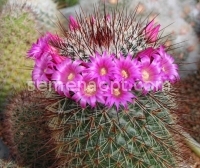
-
- Notice
- No new notifications
-
- Messages
- See all notifications
-
18
- The cart
In the basket 0
in the amount of 0 RUB
- Go to basket
Vegetable seeds Flower seeds Grapes (plants) Mushrooms Agrochemicals
|

|
|
  
|
Motherland - Mexico (Hidalgo Real del Monte, Sierra Rosa) . Stem initially spherical, then extended up to 15 cm in height and up to 7 cm in diameter , green, later gray-blue, kustyaschiysya; aksily naked; conical nipples; to escape 16 - 18 off-white radial spines, up to 8mm central spines usually 6 to 1.5 cm in length, these spikes are different in color, yellow or brown to red; flowers up to 7 cm long, pale carmine . Genus Mammillaria Haw . - Mammillaria - the most numerous genus of the family Cactaceae . It has 350 species and 98 varieties . Rod is divided into 3 sections hydor-hilum - with watery juice,galaktos-chylos - with milky juice and hydro sub-chymos, whose sap is available only in the central vessels . Depending on the shape of the nipple, stem and thorns, and the magnitude of flowers and other signs of these sections are divided into further sub pas, group and subgroups . Appearance Mammillaria, their flowers, thorns and pubescence unusually varied. Distinguishingfeature is a kind of lack of edges, instead of which the stem of the plant is covered with papillae, and the special structure of the areola: it is divided into two parts - one carrying the spikes, is at the end of the papilla, the other - and vegetative - is in aksile (the depression between the papillae) . The flowers appear from last year's axilla around the top . After flowering, the fruit is formed immediately, it gradually emerges from the axilla . Plant of the genus Mammillaria culture mostly unpretentious . In the summer they need moisture and the sun (with shading from strong heat), in the winter - cold and dry content at + 8, + 10 ° . Some authors (Pazhout, etc. . . ) Identify groups Mammillaria the general background,which is created by covering their stem pubescence . very beautiful white (M . bocasana, M . kandnda, M . plumosa and M . hahniana) and yellow Mamillaria (M . elongata, especially its kind Stella-aurate, M . Pringles, M . goal-ziana and others), pubescence which hairs, spines and bristles often completely covers the buds on the stem and looks veryeffectively . White Mamillaria grow in mountainous areas of central and northern Mexico on limestone and chalk cliffs . They no other cacti need light and sun and requires the addition of lime to the soil . ,
| SPECIFICATIONS | |
|---|---|
| Description | |
| In room culture | cultivated mostly unpretentious |
| It is typical for him | more than any otherCacti need light and the sun and require supplements to the soil lime |
| Grows | white Mamillaria grow in mountainous areas of central and northern Mexico on limestone and chalk cliffs |
| Features | summer they need moisture and the sun (with shading from strong heat), in the winter - dry and cold content at + 8, + 10 ° |
| Motherland | Mexico (Hidalgo Real del Monte,Dew Sierra) |
| Rod | Mammillaria Haw . , 350 includes 98 species and varieties |
| Flowers | |
| Color | light carmine |
| Diameter | 7 cm long |
| Features | the last year of the axilla appear around the top |
| Fruits | |
| Features | afterflowering fruit is formed immediately, it gradually emerges from aksily |
| Spikes | |
| Per stem | 16 - 18 whitish radial studs, length 8 mm |
| Features | 6 central spines usually a length of 1.5 cm, these spikes are different in color, yellow or brown, to red |
| Trunk | |
| Diameter | 7 cm |
| Areola | it is divided into two parts - one carrying the spikes, is at the end of the papilla, the other - and vegetative - located in the axilla |
| Form | stem initially spherical, then elongated, aksily naked, nipple cones |
| Height | 15 cm |
| Color | green, later gray-blue |
| Branching | bushy |
acanthocalycium backbg .
aporocactus lem
astrophytum lem .
austrocylindropuntia backbg
aylostera speg .
brasilicactus backbg .
brasiliopuntia (k . sch . ) berg .
cephalocerciis pfeiff .
cereus mill .
cleistocactus lem .
cliamaecereus br . et r .
copiapoa br . et r .
coryphantha (eng . ) lem .
dolichothele (k . sch . ) br . et r
echinocactus lk . et o .
echinocereus eng .
echinofossulocactus lawr .
echinopsis zucc .
epiphiliopsis berg .
epiphillum haw .
eriocactiis backbg .
eriocereus (berg . ) ricc .
espostoa br . et r .
ferocactus br . et r .
frailea br . ef r .
gymnocaclus backbg .
gymnocalycium pfeiff .
hamatocactus br . et r
hatiora br . et r .
helianthocereus backbg .
heliocereus (berg . ) br . et r .
horridocactus backbg .
hylocereus br . et r .
lepismium
lobivia br . et r .
loxanthocereus backbg .
mammillaria haw
matucana br . et r .
mila br . et r .
myrtillocactus cons .
neochilenia backbg .
neoporteria br . et r .
notocactus (k . sch . ) berg .
opuntia (tournef . ) mill .
oreocereus (berg . ) ricc .
parodla speg .
peireskia (plum . )
peireskiopsis br . et r
pseudolobivia backbg .
rebutia k . sch .
rhipsalis gartn .
selenicereus (berg . ) br . et r
tephrocactus lem .
trichocereus (berg . ) ricc .
weingartia word .
zygocactus k . sch .
Enter your information
To recover the password
Forgot password? Enter your e-mail
Registration for new users
Enter your details: